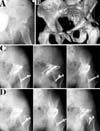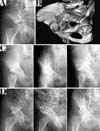Abstract
Materials and Methods
Results
Figures and Tables
 | Fig. 1(A) Initial radiograph of a 37 years old male shows transverse and posterior wall fractue.
(B) 3-Dimensional CT scan shows displaced fracture at the weight bearing dome.
(C) Immediate postoperative radiograph shows anatomical reduction with dual loop cerclage wiring and plate fixation.
(D) Radiograph after 19 months after operation shows well union of the fracture site and good joint congruency.
|
 | Fig. 2(A) Initial radiograph of a 66 years old male shows both column fracture with spur sign.
(B) 3-Dimensional CT scan shows comminuted fracture at the medial wall and anterior column.
(C) Immediate postoperative radiograph shows anatomical reduction with dual loop cerclage wiring.
(D) Radiograph after 21 months after operation shows well union of the fracture site and good joint congruency.
|
Table 1
Patient data

A: Case number; B: Fracture type, BC: Both columns, ACPH: Anterior column & posterior hemitransverse, TPW: Transverse & posterior wall fracture, TS: T-shaped; C: Age; D: Sex, M: Male, F: Female; E: Operative approach, IL: Ilioinguinal, KL: Kocher-Langenbeck, KL+LIL: Kocher-Langenbeck+Limited Ilioinguinal, TR: Triradiate transtrochanteric; F: Fixation method, SW: Single loop cerclage wire, DW: Dual loop cerclage wire, CW+P: Cerclage wire+plate, CS: Cerclage wire+screw; G: Radiologic result; H: Clinical result, E: Excellent, G: Good, F: Fair, P: Poor; I: Complication, N: None, OA: Osteoarthritis, HO: Heterotopic ossifiaction, I: Infection.




 PDF
PDF ePub
ePub Citation
Citation Print
Print


 XML Download
XML Download